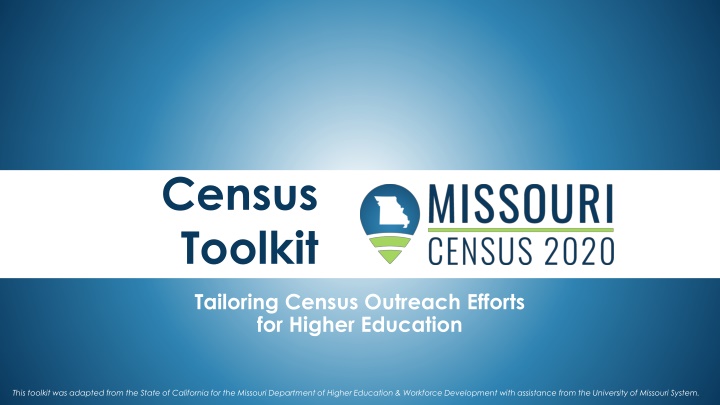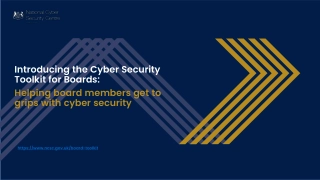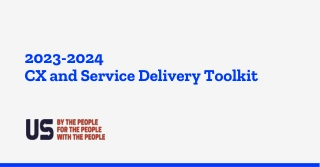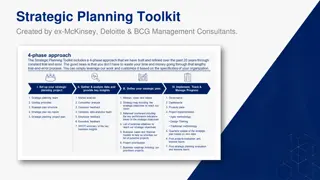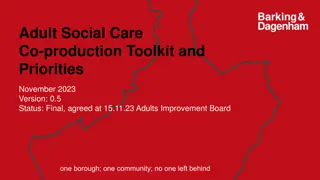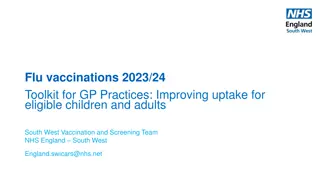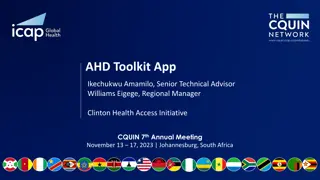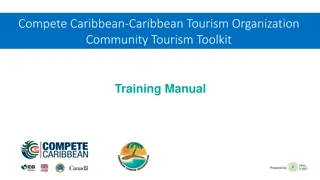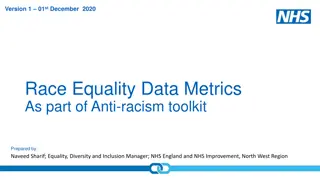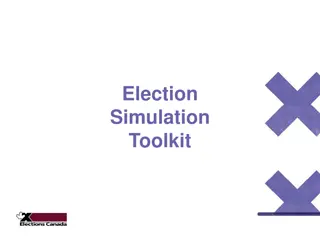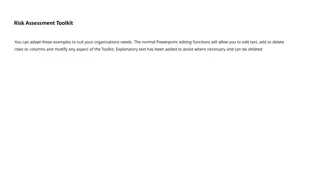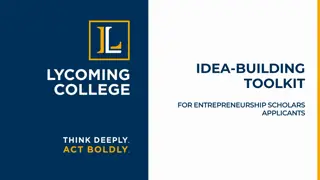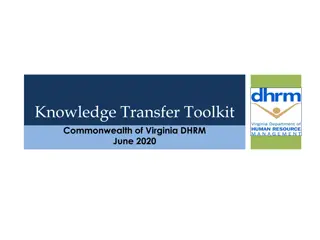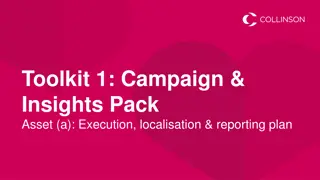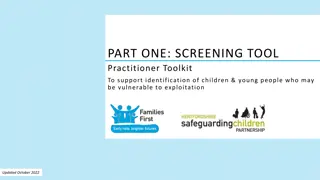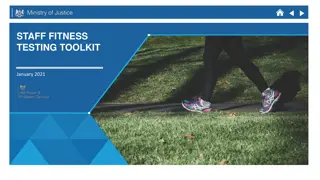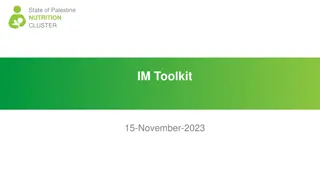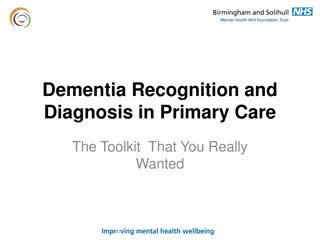Toolkit
This toolkit, adapted for Missouri, provides strategies to engage college students in the Census. Learn the importance, timelines, and effective outreach methods. Ensure students are counted in the 2020 Census.
Uploaded on Feb 25, 2025 | 0 Views
Download Presentation

Please find below an Image/Link to download the presentation.
The content on the website is provided AS IS for your information and personal use only. It may not be sold, licensed, or shared on other websites without obtaining consent from the author.If you encounter any issues during the download, it is possible that the publisher has removed the file from their server.
You are allowed to download the files provided on this website for personal or commercial use, subject to the condition that they are used lawfully. All files are the property of their respective owners.
The content on the website is provided AS IS for your information and personal use only. It may not be sold, licensed, or shared on other websites without obtaining consent from the author.
E N D
Presentation Transcript
Census Toolkit Tailoring Census Outreach Efforts for Higher Education This toolkit was adapted from the State of California for the Missouri Department of Higher Education & Workforce Development with assistance from the University of Missouri System.
How to use this toolkit Familiarize yourself with when things are happening specifically related to colleges and universities. Understand why the Census is important to your campus, your students, Missouri, and the nation. Get quick tips & best practices on how to design your student outreach campaign based on behavioral science research. Step 1: Timeline for Higher Ed Institutions Step 2: Why the Census Matters Step 3: Effective Outreach Strategies Consider suggested resources and ideas to identify which means are available and will work best at your campus. Review key points and sample messages to get started in developing plans and materials to reach your student populations. Create a Census Strategic Student Engagement Plan that s unique and specific to your campus outreach efforts. Step 4: Connecting Campus Resources Step 5: Consider Key Points and Messages Step 6: Tailor Your Outreach
STEP 1 TIMELINE FOR HIGHER EDUCATION INSTITUTIONS
U.S. Census Day is April 1, 2020 Most people will complete the Census Surveys online a first in American history! Make sure students living in dorms and other group quarters are counted. The U.S. Census Bureau includes college residence halls as part of their Group Quarter (GQ) target groups. A question for many students may be, What is my usual residence? Is it my dorm or my parents home? Right now, the U.S. Census Bureau plans to send post cards with information on how to complete the Census online. Students are to complete the Census where they are living on April 1, 2020. For Missouri colleges and universities, that will typically mean that students complete the Census survey on campus. Students should complete their e-responses between April 1, 2020, and May 1, 2020. Students who are living away from home on April 1, 2020 should count themselves separately from their families at the on-or off-campus residence where they live and sleep most of the time.
Dates to Remember Start planning early! Develop strategic engagement plans for reaching out to students about the Census. U.S. Census Bureau launches Group Quarter Advance Contact with colleges and universities Starting February 3, 2020 U.S. Census Bureau mails households cards with PIN numbers to be used for filling out the Census form, including students residences Starting March 12, 2020 April 1, 2020 Census Day U.S. Census Bureau begins efforts to count students living in residence halls and other group quarters, referred to as Group Quarters enumeration April 2, 2020 U.S. Census Bureau launches internet link for individuals to complete the Census Survey online March 12 to May 12, 2020
STEP 2 WHY THE CENSUS MATTERS
How You, Your Community and Campus Benefit from Census Data Once a decade, America comes together to participate in the Census, creating national awareness and statistics. Individuals data are confidential. College students benefit from federal student loans, legislation, campus funding, campus improvements, and health and social services. The U.S. Census Bureau s mission is to serve as the leading source of quality data about the nation s people and economy. Federal law protects your Census responses. Answers can only be used to produce statistics. It s in the Constitution. Local government officials use the Census to ensure public safety, provide health care, and improve schools and hospital facilities. The Census Bureau conducts the decennial Census, the American Community Survey, the economic Census, and many other surveys. Businesses use Census data to decide where to build factories, offices, and stores that create jobs and serve local communities. The U.S. Constitution requires a Census every 10 years. The Census covers the entire country and everyone living here. The first Census was conducted in 1790. Federal funds, grants, and support to states, counties, academia, and communities are based on population totals and breakdowns by sex, age, race, and other factors. City planners and real estate developers use the Census to improve transportation and infrastructure, including affordable housing.
Understand Student Impact Missouri Census 2020 needs your help because you care about: Quick facts about Missouri The Census is also important for: Redistricting. After each Census, state officials use the results to redraw the boundaries of their congressional and state legislative districts, adapting to population shifts. Missouri has nearly 6 million residents, and is the 18th most populated state in the U.S. Federal student loans Federal research grants Campus funding 338,515 college students in Missouri were enrolled at universities, colleges, and community colleges in Fall 2019. Fair representation. Every 10 years, the results of the Census are used to reapportion the U.S. House of Representatives, determining how many seats each state gets. Campus improvements, including labs, buildings, and classrooms Health and social services In 2017-18, 104,364 Missourians were awarded $431,411,598 in Pell Grants based in part on Census data. Federal legislation Billions of dollars at stake. Census data determine the allocation of billions of dollars to support your state, county, and community s vital programs. Students future careers many professionals are heavily dependent on federal funding (e.g., medicine, social work, nursing, science, research, or public health) Census survey data are one factor to determine the funding for many programs in higher education.
STEP 3 EFFECTIVE OUTREACH STRATEGIES
Which College Students are Hardest to Count? Use this chart to determine which students are the hardest to count. The U.S. Census Bureau identifies all college students as Hard to Count. College Student Profile (Number or Percent of Students) Hard-to-Count College Student Demographics Some college students are even harder to survey because of additional factors. College students between the ages of 18 and 24 College students from low-income backgrounds College students of recent immigrants Use the table to help: Understand the challenges in reaching students. Customize your approach in your Census strategic student engagement plan. First generation college students College students from homes who speak English with limited or no proficiency College students who are non-White College students who are homeless or lack stable housing College students living off campus and rent College students living off campus with their families College students living on campus
Identify How Best to Reach Students Missouri campuses are made up of diverse student populations. Student Populations Best means for reaching Where they live Live on campus Live nearby, but off campus Commute a distance to campus Lack stable housing (couch surfers or homeless) Demographics of Hard-to-Count Student Populations (and who they may identify with/as) International students LGBTQ+ Dreamers/Undocumented students Student veterans, ROTC Parenting students Hispanics Other ethnicities (African American, Asian, Native American, Southeast Asian, etc.) Educational purposes Undergraduate Graduate and professional school students Continuing education Adult education Vocational education Use the table to help: Plan how best to reach each, especially the hard-to-count. Consider resources available to reach each group. For example, international students may need additional help, so you might: Connect with your international student department. Collaborate to offer a designated location or time to connect with language assistance resources.
Plan the Campaign Plan your campaign to reach the student audience you hope to engage. Think about what s important to them and what motivates them. 1. Make it clear why the Census is important for students and the institution. Why should students care? It s easy to forget that what you re advocating for, which you know a lot about, may not be as clear to students who are just becoming aware of the Census. Frame the why of taking an action as a value proposition that s important to students. 3. Create a checklist. What are the steps departments, students, or student organizations should take? It helps to outline a clear to-do list or action steps. Start each step with an action verb of what needs to be done. Help groups know what to expect or how they can help. Make sure the Census is accessible to all. 2. Prompt campus departments and student organizations to make a plan. What kind of planning do campus organizations need to do? There is a gap between what we intend to do and what we actually do. To help close this gap, this toolkit contains checklists and templates to help plan your campus Census campaign. Have departments and student organizations indicate when they ll do something, how they ll do it, and other critical details. 4. Consider the right incentives. How can we make our incentives seem even better? Both financial and non-financial incentives can be powerful motivators. Whenever using incentives, consider the timing and context for the incentives. For example, if offering a bookstore coupon, a $1 coupon for a $5 item is much more exciting than a $1 coupon for $100 item, even though in both instances an individual is saving the same amount.
Communicate Effectively Making it easy to complete the Census is critical. Sometimes the smallest tweaks can have significant impact. Meet students where they are. 1. Keep it simple. Is all the information in our message immediately useful? Are we using simple language? Use simple and conversational language that s to the point. Provide only the most essential information. Whenever possible, describe short-term costs or benefits. Avoid over-sharing in an attempt to be thorough; include reference links to resources for those interested in learning more. 2. Consider the messenger. Who will students listen to? People pay attention to who is asking them to do something. Is it someone they know? Trust? Respect? If sending a written communication (e.g., a letter or postcard), including a photo of the person sending the message has shown to increase responsiveness. 3. Make it personal. Where can we add a personal touch? Tailor content with information and examples that are relevant to the student/group. Adding personal touches can increase response rates. For example: Addressing letters or emails with the student s name. Handwritten notes or signature template letters. 4. Consider the timing. What are students schedules like? When will the message be most relevant? People tend to discount things in the future, because they re more abstract. Pay attention to the academic calendar (e.g., mid-terms, finals, spring break, etc.) Consider when students engage most. For example, research shows: Sending emails at lunchtime results in increased click rates. Asking to sign a form at the start rather than the end reduces self- reporting errors. 5. Consider the location. Where do students spend time? Where will the message reach the most students? The selected campus setting affects students interest in hearing your message. Are you knocking on their dorm doors when re they re trying to sleep in on a Saturday morning? Or talking to them about how the Census can impact educational funding and financial aid when they are registering for classes?
Be Creative Package your messaging so it stands out. 1. Make the Census a social event. Who do students identify with or admire? We are strongly influenced by what those around us do, what we perceive to be normal or acceptable, and what others think of us. For example, students purchase products that others they admire endorse, and consider how others rate restaurants. If students publicly commit to do something, they re more likely to follow through. 2. Use the right channels. What kinds of communication channels do our students like and already use? Consider what channels are available and which students already use. While sending letters or flyers can be effective, research shows that text messages, pop-up boxes, and in-app messages are also cost- effective ways to connect. 3. Make it visual. What pictures could we use to convey our message? Start the design with pictures, and then add words, rather than starting with extensive text. Humans are drawn to pictures. Some studies show we read as little as 20% of the text on a page. 4. Create tag lines and graphic elements. What will appeal to students? We encourage you to use the Missouri 2020 Census logo for branding purposes. You can use it alone or co-branded with your school's logo. Think of creative slogans for your campus. Twitter: @MoCensus Facebook: @MoCensus2020 Instagram: @mocensus #Census2020 #MissouriCounts
STEP 4 CONNECTING CAMPUS RESOURCES
Ideas for Maximizing Student Participation Longer form messages (email blasts, letters, newsletters) from: Leadership: President or chancellor College deans Individuals with personal contact with students: Advising or counseling faculty/staff Faculty Contact your public affairs or campus communications office to help with outreach. Highlight in digital spaces: University webpage(s) Events calendars/schedules Student portals Promote in physical locations: Digital signage Bulletin boards Sidewalk displays Dedicated computer locations ADA accessible Table tents Shorter form messages (social media, login notices, flyers): Use hashtags on social channels. #MissouriCounts is the official hashtag. Platforms that are most widely used.
Using Campus Locations for Promoting the Census Think about where students frequent for setting up Census assistance kiosks or engaging students to complete the Census. Use the table below to help identify local places and points of contact. Campus Location/ Contact Person Campus Location/ Contact Person Facility/Resource Facility/Resource Student union Parking facilities Libraries Recreation centers Bookstore Kiosks Dining halls, cafes, cafeterias Gymnasiums Departmental offices Faith-based organizations Dormitories Facilities management leadership Museums, galleries Other
Engaging Student Organizations Engaging student organizations in the campus Census campaign can be one of your most effective strategies. Engage student activist organizations and student governments (e.g., student senate, associated student government) and encourage them to: Adopt resolutions about the importance of the Census. Develop their own outreach plans. Encourage student groups to set up informational tables or booths on campus about the Census. Create friendly competitions with incentives among student organizations. Tap into student groups to undertake peer-to- peer outreach. Have students identify and reach out to neighboring campus locales that students frequent to post Census posters and information. Connect with Greek organizations, housing staff, and international student staff.
STEP 5 CONSIDER KEY POINTS AND MESSAGES
Ideas for Messaging Use the suggested communications plan in your toolkit to find sample messages that work for your students. Timeframes you should think about sending messaging are: Ahead of household card mailing When students start receiving mailed cards On Census Day Near the end of the completion window
STEP 6 TAILOR YOUR OUTREACH
Action Plan Checklist Now that you ve reviewed some best practices for developing a Strategic Student Engagement Plan for the 2020 Census, you can use the toolkit checklist to make your Census support efforts as effective as possible.
Examples and printable materials to support your campus Census outreach efforts is available at: https://www.census.gov/partners/2020-materials.html Graphics and Extra Materials: https://census.mo.gov/get-involved/highered/ Promotional Videos: Shape Your Future: The 2020 Census 2020 Census PSA: What is the 2020 Census? (:30) 2020 Census PSA: How Do I Take The 2020 Census? (:20) Toolkit was adapted from the State of California for the Missouri Department of Higher Education & Workforce Development with assistance from the University of Missouri System.
